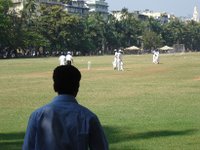 We visited Mumbai (formerly Bombay) for about 36 hours (one night) en route from Rajasthan to Goa. We saw only the wealthy and well-heeled city centre (not the large slums which are home to some 12 million people), - but we were very impressed.
We visited Mumbai (formerly Bombay) for about 36 hours (one night) en route from Rajasthan to Goa. We saw only the wealthy and well-heeled city centre (not the large slums which are home to some 12 million people), - but we were very impressed.  Mumbai is a very important Indian city. Formed as a port in the 17th century by the Portuguese and British from several islands on the West coast, it has evolved into India's commercial capital. It is also the centre of the Bollywood film, fashion, media and advertising industries (so contemporary culture). It has a tropical climate, impressive buildings, long coastal promenades and open spaces for cricket (see right).The centre is much cleaner than Delhi and, being relatively new, well organised. The sea breeze also accounts for fresher air which clears the pollution (smog sits heavy over Delhi).
Mumbai is a very important Indian city. Formed as a port in the 17th century by the Portuguese and British from several islands on the West coast, it has evolved into India's commercial capital. It is also the centre of the Bollywood film, fashion, media and advertising industries (so contemporary culture). It has a tropical climate, impressive buildings, long coastal promenades and open spaces for cricket (see right).The centre is much cleaner than Delhi and, being relatively new, well organised. The sea breeze also accounts for fresher air which clears the pollution (smog sits heavy over Delhi). There is less rubbish, fewer free-roaming cattle, fewer pigs and endless smart black and yellow taxis, rather than the usual mix of rickshaws and auto rickshaws (see Laura in front of a rank of taxis - left/ below).
 What we liked most of all though, was the sense of confidence in the people of Mumbai. Whilst, wealthy or poor, they were polite (as they have been everywhere we've gone), there was not the strong sense of deference which we have experienced elsewhere.
What we liked most of all though, was the sense of confidence in the people of Mumbai. Whilst, wealthy or poor, they were polite (as they have been everywhere we've gone), there was not the strong sense of deference which we have experienced elsewhere.
We liked that - these felt like confident people, people with ambition, people who truly believed in the future, that it was theirs, and that they were going forward to get it.
Drawing hundreds of thousands of migrants from across India every year, Mumbai is a city of aspiration.
Whilst the vast majority will never achieve their dreams, Laura and I agreed it must be an electric place to live.
Joe
 We spent an evening recently in the heart of the backpacker area of Bangkok, Khao San Road (see above - the bright lights).
We spent an evening recently in the heart of the backpacker area of Bangkok, Khao San Road (see above - the bright lights).























 Joe
Joe


 Joe
Joe


 Joe
Joe














 Joe
Joe